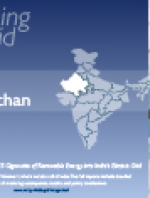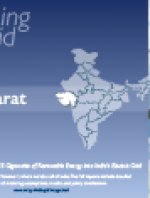Synopsis: India is making steady progress toward its target of 175 GW of renewable energy (RE) capacity by 2022
Synopsis: India’s National Tariff Policy mandates that power distribution companies (DISCOMs) purchase renewable energy (RE) to meet their renewable purchase obligation (RPO) targets. Procurement of RE, which is less predictable and variable by nature, requires systems to tackle the variability and intermittency of RE power supply and prevent demand-supply mismatches in the grid.
Synopsis: The USAID India “Greening the Grid Program” is being funded by the United States Agency for International Development (USAID) and is an initiative of the U.S. Government.
Synopsis: The purpose of this report is to understand the regulatory dimensions to renewable energy forecasting, scheduling, and balancing in India’s power grid.
Synopsis: USAID’s Greening the Grid (GTG) is a five-year program implemented in partnership with India’s Ministry of Power (MOP) under the USAID’s ASIA EDGE (Enhancing Development and Growth through Energy) Initiative.
Synopsis: India has charted a new path for energy sector reforms. Fueled by a resolute focus on clean, green power, the country is heavily investing in its renewable energy (RE) capacity. Adding a large quantum of RE generation to the
power grid will enable India to transition its energy sector to low-carbon intensity and increase its overall energy security.
Synopsis: India’s power sector is witnessing a slew of reforms aimed at shaping a robust energy landscape for the country. Real-time management of demand-supply variation — to better respond to energy requirements and to enable large-scale integration of renewable energy (RE) — is a key focus area.
Synopsis: The active power distribution network operation with the integration of variable renewable energy sources, storage units, and dynamic loads are attracting a lot of
interest due to substantial benefits in maximizing the penetration of RES. However, the risk of voltage violation in the power system is increased due to increasing the penetration of DGs/RES [1]-[3].
Synopsis: India’s Nationally-Determined Contributions (NDCs) target aims to ensure that at least 40 per cent of its electric power installed capacity in 2030 would come from non-fossil
based energy resources.
Synopsis: USAID/India‘s Greening the Grid (GTG) – Renewable Integration and Sustainable Energy (RISE) initiative (referred to as ―RISE‖ hereafter), focuses primarily on implementing a set of innovative pilots, which are multiimplementer work programs aimed at testing and evaluating building blocks to improve the integration of high levels of renewable energy (RE) in India‘s state and national power grids. AGC pilot discussed in this paper is one among the pilots proposed under RISE initiative.
Synopsis: Emerging distributed energy resources (DERs)—such as solar photovoltaics (PV), battery energy storage systems (BESS), and electric vehicles (EVs)—are expected to increase substantially in India in the coming years following policy-driven targets of the Government of India.
Synopsis: This report was produced by the National Renewable Energy Laboratory, Lawrence Berkeley National Laboratory, Power System Operation Corporation, and the United States Agency for International Development.
Synopsis: This report was produced by the National Renewable Energy Laboratory, Lawrence Berkeley National Laboratory, Power System Operation Corporation, and the United States Agency for International Development.
Synopsis: The GTG program combined four intertwined components, led by specialized partners, to validate the key building blocks of grid flexibility and inter-state power trade and create enabling conditions to scale.
Synopsis: The Greening the Grid-Renewable Integration and Sustainable Energy (GTG-RISE) program is a partnership
between the United States Agency for International Development (USAID) and the Ministry of Power,
Government of India, under the Asia.
Synopsis: One third of India’s coal based power generation capacity should be made ready for flexible generation and dynamic simulation models could play a key role. The study reports supported by USAID & IGEF are pre-cursor to ascertain flexible operations for many of these units.
Synopsis: India’s transforming energy landscape, with its emphasis on renewable energy (RE), holds manifold promises for the country’s enhanced energy security, reduced oil imports, and improved air quality.
Synopsis: United States Agency for International Development (USAID)’s Greening the Grid-Renewable Integration and Sustainable Energy (GTG-RISE) initiative, the central component of Greening the Grid (GTG) program, is a bilateral program with the Ministry of Power,
Government of India, under the U.S.-India Strategic Clean Energy Partnership (SCEP).
Synopsis: USAID/India‘s Greening the Grid (GTG) – Renewable Integration and Sustainable Energy (RISE) initiative (referred to as ―RISE‖ hereafter), focuses primarily on implementing a set of innovative pilots, which are multiimplementer work programs aimed at testing and evaluating building blocks to improve the integration of high levels of renewable energy (RE) in India‘s state and national power grids. AGC pilot discussed in this paper is one among the pilots proposed under RISE initiative.
Synopsis: The addition of RE in Gujarat changes net load, which is the load that is not met by RE and therefore must be met by conventional generation. Due to changes in net load, hydro and thermal plants operate differently in higher RE scenarios.
Synopsis: The addition of RE in Andhra Pradesh changes net load, which is the load that is not met by RE and therefore must be met by conventional generation. Due to changes in net load, hydro and thermal plants operate differently in higher RE scenarios.
Synopsis: This report proviides state-specific results for Tamil Nadu from Pathways to Integrate 175 Gigawatts of Renewable Energy into India’s Electric Grid Volume II.
Synopsis: This report proviides state-specific results for Gujarat from Pathways to Integrate 175 Gigawatts of Renewable Energy into India’s Electric Grid Volume II.
Synopsis: This report proviides state-specific results for Rajastha from Pathways to Integrate 175 Gigawatts of Renewable Energy into India’s Electric Grid Volume II.
Synopsis: This report proviides state-specific results for Karnataka from Pathways to Integrate 175 Gigawatts of Renewable Energy into India’s Electric Grid Volume II.
Synopsis: This report proviides state-specific results for Gujarat from Pathways to Integrate 175 Gigawatts of Renewable Energy into India’s Electric Grid Volume II.
Synopsis: This report proviides state-specific results for Andhra Pradesh from Pathways to Integrate 175 Gigawatts of Renewable Energy into India’s Electric Grid Volume II.
Synopsis: The purpose of this report is to understand the regulatory dimensions to renewable energy forecasting, scheduling, and balancing in India’s power grid.
Synopsis: The Government of India is working to deploy unprecedented levels of renewable energy (RE) on its power grid. Getting a large quantum of RE on the gird will allow India to greatly reduce its economy’s carbon intensity and substantially strengthen the country’s energy security.
Synopsis: Renewable energy (RE) generation in India has been on a steady rise. Ensuring the power system’s reliability in the face of increased RE penetration is critical
































